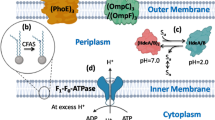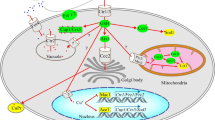Abstract
Several recent reports described an apoptosis-like programmed cell death (PCD) process in yeast in response to different environmental challenges. In this study, hyperosmotic stress caused by high NaCl concentration in culture medium induced cell death in the haploid yeast Torulopsis glabrata. Propidium iodide (PI) and PI/rhodamine-123 (Rh123) dual staining with flow cytometry showed that high salinity decreased intact cells by 16.5 %, increased necrotic cells by nearly twofold, and altered fermentative parameters appreciably. Morphological and biochemical indicators of apoptosis were apparent, specifically a decrease in mitochondrial membrane potential (∆Ψm), translocation of phosphatidylserine (PS) from the inner to the outer side of the plasma membrane, generation of reactive oxygen species (ROS), and involvement of caspase all while plasma membrane integrity was maintained. Additionally, it was found that overexpression of YCA1 drastically stimulated cell death, indicating that activation of metacaspase might lead to cell death. However, T. glabrata growth under hyperosmotic stress was enhanced when FIS1, HOG1, and GPD2 were overexpressed, or when exogenous proline or glutathione (GSH) were added into the cultures, both of which could repress caspase-3 activity. Thus, in these concrete cases of overexpression of anti-apoptotic or anti-necrotic factors and pharmacological manipulations, it decreased T. glabrata cell death that might help to achieve higher fermentative efficiency.





Similar content being viewed by others
References
Alnemri ES, Livingston DJ, Nicholson DW, Salvesen G, Thornberry NA, Wong WW, Yuan JY (1996) Human ICE/CED-3 protease nomenclature. Cell 87:171
Ansell R, Granath K, Hohmann S, Thevelein JM, Adler L (1997) The two isoenzymes for yeast NAD+-dependent glycerol 3-phosphate dehydrogenase encoded by GPD1 and GPD2 have distinct roles in osmoadaptation and redox regulation. EMBO J 16:2179–2187
Bilsland-Marchesan E, Arino J, Saito H, Sunnerhagen P, Posas F (2000) Rck2 kinase is a substrate for the osmotic stress-activated mitogen-activated protein kinase Hog1. Mol Cell Biol 20:3887–3895
Büttner S, Eisenberg T, Carmona-Gutierrez D, Ruli D, Knauer H, Ruckenstuhl C, Sigrist C, Wissing S, Kollroser M, Fröhlich KU, Sigrist S, Madeo F (2007) Endonuclease G regulates budding yeast life and death. Mol Cell 25:233–246
Carmona-Gutierrez D, Eisenberg T, Büttner S, Meisinger C, Kroemer G, Madeo F (2010) Apoptosis in yeast: triggers, pathways, subroutines. Cell Death Differ 17:763–773
Carmona-Gutierrez D, Sommer C, Andryushkova A, Kroemer G, Madeo F (2012) A higher spirit: avoiding yeast suicide during alcoholic fermentation. Cell Death Differ 19:913–914
Chen CB, Dickman MB (2005) Proline suppresses apoptosis in the fungal pathogen Colletotrichum trifolii. Proc Natl Acad Sci U S A 102:3459–3464
Creagh EM, Martin SJ (2001) Caspases: cellular demolition experts. Biochem Soc Trans 29:696–702
Danial NN, Korsmeyer SJ (2004) Cell death: critical control points. Cell 116:205–219
Ding JM, Huang XW, Zhang LM, Zhao N, Yang DM, Zhang KQ (2009) Tolerance and stress response to ethanol in the yeast Saccharomyces cerevisiae. Appl Microbiol Biot 85:253–263
Eisenberg T, Büttner S, Kroemer G, Madeo F (2007) The mitochondrial pathway in yeast apoptosis. Apoptosis 12:1011–1023
Emaus RK, Grunwald R, Lemasters JJ (1986) Rhodamine 123 as a probe of transmembrane potential in isolated rat-liver mitochondria: spectral and metabolic properties. Biochim Biophys Acta 850:436–448
Estruch F (2000) Stress-controlled transcription factors, stress-induced genes and stress tolerance in budding yeast. FEMS Microbiol Rev 24:469–486
Fahrenkrog B, Sauder U, Aebi U (2004) The S. cerevisiae HtrA-like protein Nma111p is a nuclear serine protease that mediates yeast apoptosis. J Cell Sci 117:115–126
Fannjiang Y, Cheng WC, Lee SJ, Qi B, Pevsner J, McCaffery JM, Hill RB, Basanez G, Hardwick JM (2004) Mitochondrial fission proteins regulate programmed cell death in yeast. Genes Dev 18:2785–2797
Gottlieb RA (2001) Mitochondria and apoptosis. Biol Signals Recept 10:147–161
Guaragnella N, Pereira C, Sousa MJ, Antonacci L, Passarella S, Côrte-Real M, Marra E, Giannattasio S (2006) YCA1 participates in the acetic acid induced yeast programmed cell death also in a manner unrelated to its caspase-like activity. FEBS Lett 580:6880–6884
Higgins VJ, Beckhouse AG, Oliver AD, Rogers PJ, Dawes IW (2003) Yeast genome-wide expression analysis identifies a strong ergosterol and oxidative stress response during the initial stages of an industrial lager fermentation. Appl Environ Microbiol 69:4777–4787
Hohenblum H, Borth N, Mattanovich D (2003) Assessing viability and cell-associated product of recombinant protein producing Pichia pastoris with flow cytometry. J Biotechnol 102:281–290
Hohmann S (2002) Osmotic stress signaling and osmoadaptation in yeasts. Microbiol Mol Biol Rev 66:300–372
Huh GH, Damsz B, Matsumoto TK, Reddy MP, Rus AM, Ibeas JI, Narasimhan ML, Bressan RA, Hasegawa PM (2002) Salt causes ion disequilibrium-induced programmed cell death in yeast and plants. Plant J 29:649–659
Inoue H, Nojima H, Okayama H (1990) High efficiency transformation of Escherichia coli with plasmids. Gene 96:23–28
Khan MAS, Chock PB, Stadtman ER (2005) Knockout of caspase-like gene, YCA1, abrogates apoptosis and elevates oxidized proteins in Saccharomyces cerevisiae. Proc Natl Acad Sci U S A 102:17326–17331
Kitagaki H, Araki Y, Funato K, Shimoi H (2007) Ethanol-induced death in yeast exhibits features of apoptosis mediated by mitochondrial fission pathway. FEBS Lett 581:2935–2942
Kroemer G, Reed JC (2000) Mitochondrial control of cell death. Nat Med 6:513–519
Landolfo S, Politi H, Angeozzi D, Mannazzu I (2008) ROS accumulation and oxidative damage to cell structures in Saccharomyces cerevisiae wine strains during fermentation of high-sugar-containing medium. BBA 1780:892–898
Larsson S, Cassland P, Jonsson LJ (2001) Development of a Saccharomyces cerevisiae strain with enhanced resistance to phenolic fermentation inhibitors in lignocellulose hydrolysates by heterologous expression of laccase. Appl Environ Microbiol 67:1163–70
Li Y, Chen J, Lun SY, Rui XS (2001) Efficient pyruvate production by a multi-vitamin auxotroph of Torulopsis glabrata: key role and optimization of vitamin levels. Appl Microbiol Biot 55:680–685
Li W, Sun LB, Liang QL, Wang J, Mo WK, Zhou B (2006) Yeast AMID homologue Ndi1p displays respiration-restricted apoptotic activity and is involved in chronological aging. Mol Biol Cell 17:1802–1811
Liu LM, Li Y, Li HZ, Chen J (2004) Manipulating the pyruvate dehydrogenase bypass of a multi-vitamin auxotrophic yeast Torulopsis glabrata enhanced pyruvate production. Lett Appl Microbiol 39:199–206
Liu LM, Li Y, Zhu Y, Du GC, Chen J (2007) Redistribution of carbon flux in Torulopsis glabrata by altering vitamin and calcium level. Metab Eng 9:21–29
Ludovico P, Sansonetty F, Côrte-Real M (2001) Assessment of mitochondrial membrane potential in yeast cell populations by flow cytometry. SGM: Microbiol 147:3335–3343
Ludovico P, Rodrigues F, Almeida A, Silva MT, Barrientos A, Côrte-Real M (2002) Cytochrome c release and mitochondria involvement in programmed cell death induced by acetic acid in Saccharomyces cerevisiae. Mol Biol Cell 13:2598–2606
Ludovico P, Sansonetty F, Silva MT, Côrte-Real M (2003) Acetic acid induces a programmed cell death process in the food spoilage yeast Zygosaccharomyces bailii. FEMS Yeast Res 3:91–96
Ly JD, Grubb DR, Lawen A (2003) The mitochondrial membrane potential (∆Ψm) in apoptosis; an update. Apoptosis 8:115–128
Madeo F, Fröhlich E, Fröhlich KU (1997) A yeast mutant showing diagnostic markers of early and late apoptosis. J Cell Biol 139:729–34
Madeo F, Fröhlich E, Ligr M, Grey M, Sigrist SJ, Wolf DH, Fröhlich KU (1999) Oxygen stress: a regulator of apoptosis in yeast. J Cell Biol 145:757–767
Madeo F, Herker E, Maldener C, Wissing S, Lachelt S, Herian M, Fehr M, Lauber K, Sigrist SJ, Wesselborg S, Fröhlich KU (2002) A caspase-related protease regulates apoptosis in yeast. Mol Cell 9:911–917
Marks VD, Sui SJH, Erasmus D, van der Merwe GK, Brumm J, Wasserman WW, Bryan J, van Vuuren HJJ (2008) Dynamics of the yeast transcriptome during wine fermentation reveals a novel fermentation stress response. FEMS Yeast Res 8:35–52
Mitsui K, Nakagawa D, Nakamura M, Okamoto T, Tsurugi K (2005) Valproic acid induces apoptosis dependent of Yca1p at concentrations that mildly affect the proliferation of yeast. FEBS Lett 579:723–727
Nicolaou SA, Gaida SM, Papoutsakis ET (2010) A comparative view of metabolite and substrate stress and tolerance in microbial bioprocessing: from biofuels and chemicals, to biocatalysis and bioremediation. Metab Eng 12:307–331
Petronilli V, Cola C, Massari S, Colonna R, Bernardi P (1993) Physiological effectors modify voltage sensing by the cyclosporin A-sensitive permeability transition pore of mitochondria. J Biol Chem 268:21939–45
Posas F, Saito H (1997) Osmotic activation of the HOG MAPK pathway via Ste11p MAPKKK: scaffold role of Pbs2p MAPKK. Science 276:1702–1705
Pozniakovsky AI, Knorre DA, Markova OV, Hyman AA, Skulachev VP, Severin FF (2005) Role of mitochondria in the pheromone- and amiodarone-induced programmed death of yeast. J Cell Biol 168:257–269
Salvesen GS, Dixit VM (1997) Caspases: intracellular signaling by proteolysis. Cell 91:443–446
Santos H, da Costa MS (2002) Compatible solutes of organisms that live in hot saline environments. Environ Microbiol 4:501–509
Scaduto RCJ, Grotyohann LW (1999) Measurement of mitochondrial membrane potential using fluorescent rhodamine derivatives. Biophys J 76:469–477
Sharon LM, Thomas GC (1999) Inhibition of caspase activity delays apoptosis in a transfected NS/0 myeloma cell line. Biotechnol Bioeng 67:165–176
Silva RD, Sotoca R, Johansson B, Ludovico P, Sansonetty F, Silva MT, Peinado JM, Côrte-Real M (2005) Hyperosmotic stress induces metacaspase- and mitochondria-dependent apoptosis in Saccharomyces cerevisiae. Mol Microbiol 58:824–834
Smaili SS, Hsu YT, Youle RJ, Russell JT (2000) Mitochondria in Ca2+ signaling and apoptosis. J Bioenerg Biomembr 32:35–46
Ubezio P, Civoli F (1994) Flow cytometric detection of hydrogen peroxide production induced by doxorubin in cancer cells. Free Radic Biol Med 16:509–516
Vander Heiden MG, Chandel NS, Williamson EK, Schumacker PT, Thompson CB (1997) Bcl-x(L) regulates the membrane potential and volume homeostasis of mitochondria. Cell 91:627–637
Wadskog I, Maldener C, Proksch A, Madeo F, Adler L (2004) Yeast lacking the SRO7/SOP1-encoded tumor suppressor homologue show increased susceptibility to apoptosis-like cell death on exposure to NaCl stress. Mol Biol Cell 15:1436–1444
Walter D, Wissing S, Madeo F, Fahrenkrog B (2006) The inhibitor-of-apoptosis protein Bir1p protects against apoptosis in S. cerevisiae and is a substrate for the yeast homologue of Omi/HtrA2. J Cell Sci 119:1843–1851
Wissing S, Ludovico P, Herker E, Büttner S, Engelhardt SM, Decker T, Link A, Proksch A, Rodrigues F, Côrte-Real M, Fröhlich KU, Manns J, Cande C, Sigrist SJ, Kroemer G, Madeo F (2004) An AIF orthologue regulates apoptosis in yeast. J Cell Biol 166:969–974
Xu GQ, Liu LM, Chen J (2012) Reconstruction of cytosolic fumaric acid biosynthetic pathways in Saccharomyces cerevisiae. Microb Cell Fact 11:24
Xu N, Liu LM, Zou W, Liu J, Hua Q, Chen J (2013) Reconstruction and analysis of the genome-scale metabolic network of Candida glabrata. Mol Biosyst 9:205–216
Zhang YH, Zhang YP, Zhu Y, Mao SM, Li Y (2010) Proteomic analyses to reveal the protective role of glutathione in resistance of Lactococcus lactis to osmotic stress. Appl Environ Microbiol 76:3177–3186
Zhou JW, Dong ZY, Liu LM, Du GC, Chen J (2009) A reusable method for construction of non-marker large fragment deletion yeast auxotroph strains: a practice in Torulopsis glabrata. J Microbiol Methods 76:70–74
Acknowledgments
This work was supported by the Major State Basic Research Development Program of China (2013CB733602), the National Natural Science Foundation of China (31270079), the Provincial Outstanding Youth Foundation of Jiangsu Province (BK2012002), and the Program for Young Talents in China.
Author information
Authors and Affiliations
Corresponding author
Electronic supplementary material
Below is the link to the electronic supplementary material.
ESM 1
PDF 221 kb
Rights and permissions
About this article
Cite this article
Yu, X., Wang, H. & Liu, L. Two non-exclusive strategies employed to protect Torulopsis glabrata against hyperosmotic stress. Appl Microbiol Biotechnol 98, 3099–3110 (2014). https://doi.org/10.1007/s00253-014-5589-7
Received:
Revised:
Accepted:
Published:
Issue Date:
DOI: https://doi.org/10.1007/s00253-014-5589-7




